![]() MARK GARDINER (with help
from Neil Mackenzie)
MARK GARDINER (with help
from Neil Mackenzie)
![]()
Day Four - Tuesday 22 May
The day dawned overcast and damp, and although it remained cloudy it also stayed dry. Our targets for the day were the swathe of rear-area cemeteries that lay to the East and South-East of Ypres, from Dikkebus to Westouter.
Heading out on the road to Poperinghe it wasn't long before we arrived at Railway Chateau Cemetery, another beautifully maintained, small and isolated site, reached via a grass path between houses with on looking farm animals. The grave references in the register are difficult to follow as there are possibly several mass burials. According to CWGC this cemetery was closed in October 1916, but contains the resting place of several soldiers who died in 1917. We were visiting Private Peter Breen of 2nd Bn. Connaught Rangers from Cork, who was a regular soldier (enlisting in 1894 aged 18) having served for 12 years and been posted to Egypt & India with a chequered history of disciplinary offences and awards for good conduct! He was with the B.E.F. having landed in France on 13 August 1914, and died following German attacks on the battalion position at Molensaarhoek on 8 November 1914.
Access to Divisional Cemetery proved difficult as the access road had been dug up, proving impassable to cars. The cemetery is of a neat triangular design, and contains the collective graves of many of the Duke of Wellington's (West Riding) men who died as a result of a gas attack on Hill 60 on 5 May 1915. We were visiting: -
Second Lieutenant Lyulph Stansfeld-Smith of 1st Bn. Wiltshire Regiment. A junior clerk from Putney with The Imperial Bank of Persia, London, he was with the Sherbourne OTC when he attested with the Honourable Artillery Company in August 1914, and arrived in France the following month with the 1st Battalion. He joined the Wiltshire's as a temporary 2nd Lieutenant on 19 January 1915. On the afternoon of 13 June 1915, aged 18, he was accidentally killed whilst holding a training session on the use of hand grenades, when he primed what he believed was a dummy but was in fact a live grenade.
Lance Corporal Fred Mitchell of 17th Division Cycling Coy., Army Cyclist Corps. From Halifax he had enlisted aged 24 on 5 September 1914 and joined the Duke of Wellington's (West Riding) regiment, before joining the Cyclist Corps in January 1915. He died of wounds on 29 October 1915.
Further down the road to Poperinghe is the village of Vlamertinge, which contains the large Vlamertinghe Military Cemetery. Immaculately maintained, we arrived early, but still didn't beat the CWGC gardeners who had started their shift early today. It is a very quiet and peaceful place despite being sited in the middle of town.
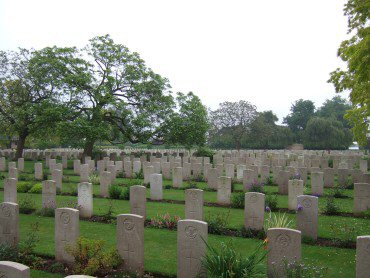
We were visiting Rifleman Fred Calvert of 10th Bn. King's Royal Rifle Corps, who hailed from Lancashire and is commemorated on the Accrington was memorial. He enlisted on 12 October 1915 and was killed in action aged 19 on 25 June 1916 during a counter-bombardment in the build-up to a trench raid.
Hop Store Cemetery was founded on the site of a field ambulance; its boundary wall is red-brick, and its long but narrow shape is dictated by the closeness to hedges and a hop store. Buried within is Private George Turnbull Telfer of 9th Bn. York & Lancaster Regiment, a wine-bar manager from Morpeth, Nothumberland, who had spent 3 years with the Northumberland Yeomanry and attested aged 32 on 11 December 1915. He landed in France on 2 May 1917 and died of wounds on 9 June 1917; his battalion was near Hill 60 and it is unclear whether he suffered his wounds in the successful assault on 7 June or in the latter German shelling. He was married with three children, the youngest of which was born three months after Fred's death.
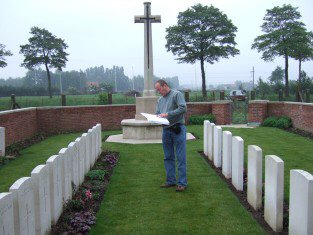 |
Just beyond Brandhoek is the tiny Red Farm Military Cemetery; there is no registry box but plenty of inquisitive sheep. There is one grave marked "3 civilian victims of the 1914-18 war." Gunner Sidney Toms of "V" 8th Heavy Trench Mortar Battery, Royal Garrison Artillery was killed in action on 27 April 1918 along with his comrades JJ Dyas, JP Horsfall and W Regan who are also buried here. A watch repairer from Exeter, he enlisted in February 1916 aged 30 and joined his unit in France in February 1917. |
Hagle Dump Cemetery is an out-of-the-way cemetery but isn't forgotten by visitors; there are comments about those buried who were "shot at dawn" in both the visitors' book and the cemetery register. We were visiting: -
Driver Frederick Mayes of A Battery, 157th Bde. Royal Field Artillery, who came from West Ham and is possibly a distant relative on Mark's grandmother's side (family history is difficult to pin down).
Second Lieutenant Alfred Ransdale of 15th Bn. Loyal North Lancashire Regiment, who travelled all the way from Argentina to die within four days of his arrival aged 23. British by birth (educated in Shoreham, Sussex), he had lived in the Argentine Republic since 1911 and was a clerk for River Plate Trust, Loan and Agency Co. Ltd. in Rosario de Santa Fe. Posted to Stone Buildings, Lincolns Inn as a Private before 9 November 1917 he was attached to No.19 OC Brigade at Pirbright. Officer commanding wrote that he was "intelligent but is weak in topography, should do all right." Discharged on 30 April 1918 upon appointment to a commission in 3rd (Reserve) Bn. The Loyal North Lancashire Regt., he arrived in Belgium on 27 August 1918 and in letters to relatives that day expressed a fear he would not survive. On 1 September 1918 his company were heavily shelled whilst acting as working parties in the front line. It is unclear whether he was killed outright or died of wounds. His will was in favour of Miss Mabel Choules of Hornchurch, Essex; unsure about the nature of the relationship but it appeared to be a secret he had kept from his family.
| Difficult to find if you've not visited it before, Hospital Farm Cemetery is one of our favourite cemeteries in The Salient, tucked away behind a farm, surrounded by trees and a beek (small stream). On our last visit the water had been frozen but now the shrubs were in full bloom. We were visiting Gunner John Finnis of 187th Siege Battery, Royal Garrison Artillery (part of 7th HAG). On 10 August 1917 the battery was in the vicinity of Vlamertinghe Chateau; Finnis and Bombardier Arthur Pearson were asleep in a dugout when it received a direct hit that killed them both - they are buried next to each other. | 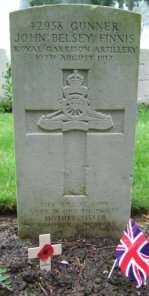 |
Heading back towards Vlamertinge and turning south off the Poperinghe-Ypres road we came to Vlamertinghe New Military Cemetery, which is a fair way from the village and surprisingly difficult to find for such a large burial site as it is hidden behind houses, and the access pathway isn't signposted. We were visiting: -
Gunner William Croston of 234th Siege Battery, Royal Garrison Artillery. Commemorated on the Accrington war memorial, he was called up on 25 July 1916 aged 27, and arrived in France in January 1917. On 16 July 1917 the battery was based on the left flank of Ypres when a hostile shell struck the left wheel of no.3 gun, putting it out of action, and killing Croston and one other gunner.
Second Lieutenant Christopher Hodgson of B Battery, 276th (2nd West Lancashire) Bde. Royal Field Artillery. The son of the rector of Beddington, Surrey, he attended Whitgift Grammar School 1892-1901, before becoming a ranch owner in West Virginia, USA, with his brother. In June 1915 he was commissioned, landing in France in December 1915, and seeing action at Kemmel, Guillemont, Guinchy and Martinpuich. He was wounded whilst in command of the battery position and died on 17 June 1917 at 2/1st Wessex Field Hospital aged 33.
Captain John Cecil Foster MC of 6th Bn. Lincolnshire Regiment. Born in 1894 he was educated at St. Peter's School, York, and enlisted in August 1914, being commissioned as a Second Lieutenant. In September 1915 he joined his battalion at the Dardanelles, and was reputedly one of the last men to leave Gallipoli when it was evacuated. On 6 March 1916 he was mentioned in despatches and promoted to Lieutenant the following day. He was awarded the MC for an action at Messines: "For conspicuous gallantry and devotion to duty. At great personal risk he made several journeys across an open space under heavy shell fire in order to keep up telephonic communication with his battalion headquarters. His fearlessness and energy in dealing with the situation when it was becoming obscure through lack of information were most invaluable." On 19 August 1917 he was killed in action by machine-gun fire on patrol in no-man's land in the Steenbeek area near St. Julien whilst temporary Captain, aged 23 (CWGC states date of death was 20 August). His brothers served in the same regiment and one was reported missing on 7 August 1915 at Chocolate Hill, Gallipoli.
Grootebeek British Cemetery is in a stunningly beautiful setting, peacefully landscaped to take advantage of water features and plants, reached via a stone flint bridge.
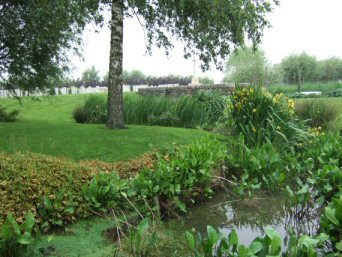
Sadly it seems to be seldom visited, with only five parties having signed the visitors' book in 2007 (although some more Brits turned up as we left). Buried here is Second Lieutenant Douglas Quirk O'Neill of 10th Bn. Royal Warwickshire Regiment, who in January 1915 enlisted in 28th (County of London) Bn. London Regiment (Artists' Rifles). He was commissioned into the Royal Warwickshire Regiment in November 1916. On 26 April 1918 his unit moved into the front line at Ouderdom and reconnoitred the line La Clytte to Brandhoek, where he was killed in action aged 27 and originally buried "about 500 yards North West of Ouderdom, Reninghelst, South West of Ypres."
In Reningelst Churchyard there is a small shale plot containing three CWGC burials.
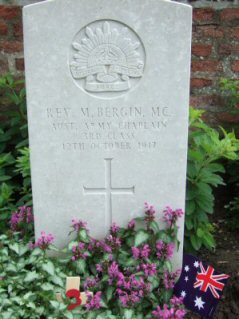
One is a Lieutenant Charles Butcher of 1st Bn. Dorsetshire Regiment, who was gassed in an enemy attack on Hill 60 on 1 May 1915 and died on the following day aged 23.
Next to the church is Reninghelst Churchyard Extension, a long narrow grass strip with the graves set against the churchyard wall; the wall opposite at points looks like it's ready to collapse. There is no registry box for wither the churchyard or the extension. Chaplain 3rd Class The Rev. Michael Bergin MC of the Australian Army Chaplains' Dept. Born 18 August 1879 he came from St. Kieran near Rosscrea in Co. Tipperary, Ireland, and held a First Year Arts Degree at the University of Ireland, Dublin and spoke French, and Arabic; formerly a professor at Holy Family College in Cairo. On 21 December 1914 he joined the Army Chaplains Dept and embarked on Persic at Sydney (although this entry is crossed out) - the 51st battalion history says he was a Jesuit priest; ejected from Palestine by the Turks, he went to Gallipoli as a stretcher bearer. After the evacuation from Gallipoli he wangled his way into the AIF though he had never been to Australia. Other notes suggest he was imprisoned by the Turks in Syria but was sent to Egypt when he contracted smallpox. Hearing of the shortage of priests in the AIF he joined them in Cairo and was commissioned on ANZAC beach. On 20 September 1917 GOC 4th Division AIF recommended Bergin for MC as "never absent from duty, always performing his Office unostentatiously but with magnificent zeal and courage. In the line or out Padre Bergin is always to be found among his men helping them when in trouble and inspiring them with his noble example and never failing cheerfulness. These are the characteristics which have endeared him to all and which make him such a valuable asset to the Brigade." On 12 October 1917 he died of wounds at 3rd Australian Field Ambulance with shrapnel wounds to the shoulder although according to Lt-Col Christie of 51st Bn. AIF he was killed near Zonnebeke on 11 October: "Our battalion was in the front line and, as was his usual custom, he went up to find out if there was anything he could do for the men. On the way to the front a piece of shell caught him in the chest, killing him instantly." His MC was gazetted on 1st January 1918.
Reninghelst New Military Cemetery is another hidden away behind houses and reached via grass chemins; it is a fair-sized cemetery with a regular layout of graves, containing many Canadian casualties from June 1916, possibly victims of the actions around Mount Sorrel. We were visiting Lieutenant-Colonel Henry de la Fontaine DSO of 9th Bn. East Surrey Regiment, he was the son of Colonel Mottet de la Fontaine of the Indian Army and had served 25 years in the East Surrey Regt., in which he reached the rank of Major in 1911. He had passed through the Staff College and was a qualified interpreter, also serving the South African War and was twice mentioned in despatches. Early in the war he went on service as DAQMG of a Division and subsequently received a higher staff appointment. Desiring, however a command, he obtained permission to leave the Staff and after the Battle of Loos he received the Lt. Colonelcy of 9th Bn. East Surreys. On 5 August 1917 he was making a personal reconnaissance in the front line trenches newly captured from the Germans near Klein Zillebeke when he was shot by a sniper.
Standing opposite a school, Westoutre British Cemetery is a small plot that slopes away from the road. We were visiting: -
Private Maurice Cronly Dillon of 23rd Bn. London Regiment, attached to 1st Bn. Royal Irish Fusiliers, who died on 15 April 1918 aged 22. He enlisted in September 1914 aged 19.
Corporal P Gibby of 15th (Service) Bn. Cheshire Regiment, who died on 4 July 1918.
Following lunch in Westouter we visited Westouter Churchyard & Extension, which consists of two grassed plots, but as with most churchyards there was no registry box. Buried here is Private Thomas Norton of 7th Bn. King's Own (Royal Lancaster Regiment), a shoemaker from Barrow-in-Furness, who attested in December 1915, and died of shrapnel wounds to the left leg on 7 June 1917 at 59th Field Ambulance aged 24.
Our journey towards Klijte was interrupted by a police checkpoint where our papers were thoroughly reviewed - a lesson that it is important to carry everything you need on a trip to Belgium. La Clytte Military Cemetery is a long strip of land in an exposed position on the crest of a ridge. We were visiting: -
Serjeant Edward Acock of 594th Mechanical Transport Coy. Army Service Corps attached to X Corps Heavy Artillery. A steam wagon driver from Plumstead who had spent 12 years in the Royal Engineers Territorial Force, he attested in May 1915 and arrived in France on September 1915.
Private Thomas Evans of 57th Coy. Machine Gun Corps (Infantry) two days after 90th anniversary of his death on 20 May 1917.
Private Albert Hillier of 5th Bn. South Wales Borderers from Newbridge, Monmouthshire, who died on 24 August 1916 aged 24, the brother of Fredrick Hillier who we were to visit at Bard Cottage Cemetery.
There is a small cluster of cemeteries around Vierstraat, the first of which is Klein-Vierstraat British Cemetery, another sited in an exposed position on a hillside.
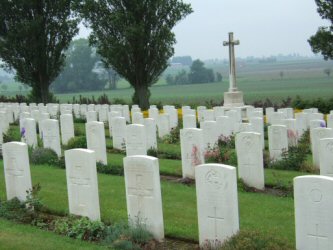
We were visiting: -
Private Henry Dewhurst of 8th Bn. East Lancashire Regiment, who died on 31st December 1917 and is commemorated on the Accrington war memorial.
Lieutenant John Freeman of X Corps Signal Coy. Royal Engineers from Sutton, Surrey, who attended Whitgift Grammar School 1908-11. He joined Royal Engineers Signals in October 1914 as 2nd Lieutenant and was promoted to Lieutenant in July 1917. Killed in action on the Ypres-Menin road (other sources state died of wounds) on 24 September 1917. He had specialized in field telegraphy & signalling, and proceeded to the front only 10 weeks before his death. His colonel wrote: "He was perfectly splendid, always cheerful, and a grand worker… He was one of the best of my boys."
On the opposite side of the road is Kemmel No.1 French Cemetery whose hillside position is less exposed in the prevailing winds. We were visiting Rifleman Harold Garman of 8th Bn. King's Royal Rifle Corps, a woodcarver from Birmingham who enlisted aged 19 in August 1914, who was reported wounded and missing on 30 July 1915, when his battalion were reinforcing the 8th Bn. Rifle Brigade in Sanctuary Wood and Zouave Wood following a German attack with flamethrowers.
Suffolk Cemetery, Vierstraat is a small regimental burial plot, with most burials being from the Suffolks in 1915 and the York & Lancaster Regiment in 1918; there is no registry box. We were visiting two representatives of these regiments: -
Second Lieutenant Francis Schroder of 2nd Bn. Suffolk Regiment who was a warehouseman from Hackney, who enlisted aged 17 at Caterham in 1910. Although CWGC gives his date of death as 15 March 1915, the battalion war diary indicates he was killed during a rifle grenade attack on 23/24 March.
Private Sydney Twite of 1st/4th Bn. York & Lancaster Regiment, who enlisted in the 11th Bn. In August 1915, and joined the 1st/4th Bn. in France in October 1916. He died of wounds on 26 April 1918 following an attack on the line La Polka - Vierstraat which failed under heavy German machine-gun fire.
Godezonne Farm Cemetery is another small site with no registry box. It was enlarged after the Armistice, but one wonders why the later burials were not interred at a larger nearby cemetery like Klein-Vierstraat British Cemetery. Corporal Thomas Kinloch Henderson of 2nd Bn. Royal Scots had enlisted in 1913, and went to France in August 1914 He was killed on 23 March 1915 aged 19 whilst the battalion was holding the line in the Vierstraat sector; it is possible he was shot by a sniper the previous day - Capt. HD Saward was killed by a sniper on 23 March and is buried in the next grave.
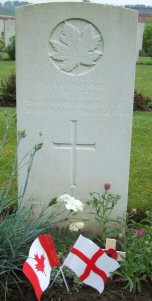 |
Ridge Wood Military Cemetery is a peaceful spot tucked away behind woods, and the CWGC gardeners were leaving just as we arrived. The lawn is immaculate and the headstones hardly appear weathered. We were visiting Private James Meath of 20th Bn. Canadian Infantry (Central Ontario Regiment) who was born in Accrington in 1894 and is commemorated on the local war memorial. The family appear to have emigrated to Ontario where he attested in November 1914 aged 20. He was killed in action on 25 March 1916 when working parties were present at Bois Carre and Brasserie when a "whiz-bang" exploded during German shelling. |
Into Dikkebus and on to Dickebusch New Military Cemetery where we met the same CWGC gardeners we'd encountered at the start of the day in Vlamertinge busy polishing the registry box. We were visiting Second Lieutenant Arthur Merrett of 15th Bn. Hampshire Regiment, who lived in Coulsdon and is commemorated on the Coulsdon & Purley war memorial. He enlisted in the Artists' Rifles in November 1915 before being commissioned into the Hampshire Regiment. On 18 December 1916 his unit was in Mud Patch during a day when trench mortars were active; he was killed aged 26.
Directly opposite is Dickebusch New Military Cemetery Extension where we visited: -
Private Leon Linge of 7th Bn. Queen's Own (Royal West Kent Regiment), a stock exchange clerk from Forest Hill, London. He had enlisted in September 1914 aged 19 and died of gunshot wounds to the head on 8 July 1917, possibly at 90th Field Ambulance.
Private William Maudsley of 20th (Labour) Bn. Cheshire Regiment, transferred to 61st Coy. Labour Corps. He is commemorated on the Accrington war memorial.
A short walk towards the village centre is Dickebusch Old Military Cemetery, which is less well-ordered than its successors, with plenty of spare space available, although the grass could do with a trim! We were visiting: -
Lieutenant George Stacpoole of 1st Bn. Royal Irish Regiment, who was born in Liverpool to an Irish family on 10 January 1892 and attended Eton College. He was shot through the head on 27 January 1915 whilst checking enemy sap heads just off the road south of St. Eloi.
Company Serjeant Major William Norris of 4th Bn. Rifle Brigade from Winchester, who was killed on 10 March 1915 according to CWGC records, although the battalion war diary for 9 March states they were in the trenches near St. Eloi before being relieved and moving to Dickebusch.
Not far from Dikkebus is The Huts Cemetery, an isolated but large and well-maintained cemetery. Many of the casualties are gunners. The five headstones in the eastern corner are all broken off and are to be replaced. We were visiting Gunner Frederick Duckworth of 51st Siege Battery, Royal Garrison Artillery, who came from Great Harwood in Lancashire, and is commemorated on the local war memorial. A carpenter & joiner, and also a member of the Grand Lodge of England, he was called up in Blackburn in March 1916 and was sent to France on 11 September 1917. Not one month later he was killed in action on 19 October 1917, aged 35.
On the way back into Ypres is the evocatively-named Belgian Battery Corner Cemetery, another gunners' burial place. It is beautifully set out in a peaceful location. We were visiting Private Herbert Akred of 8th Bn. South Lancashire Regiment who was a tramway conductor from Accrington, where he is commemorated. He attested in December 1915 and mobilised on 29 March 1916, being sent to France with the 2nd Bn. in September 1916. In October 1916 he was invalided back to England with gunshot wounds to the groin. He returned to France with the 8th Bn. in June 1917 having married Agnes on 31 March. He was killed in action on 22 July 1917 aged 27; his daughter Bertha was born on 10 October 1917.
As we had made such good progress we decided to take in Ypres Reservoir Cemetery, which is not far from our accommodation. This is a large cemetery near the prison and football stadium, but it's not quiet due to the nearby road and houses. The stones are weathered - perhaps due to exhaust emissions? We were visiting: -
Lance Corporal James Duckett of 1st/5th Bn. East Lancashire Regiment, who is commemorated on the Accrington war memorial, and died on 14 September 1917.
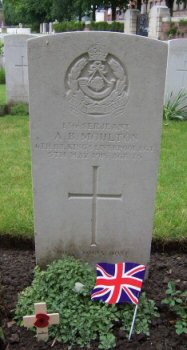 |
Serjeant Arthur Moulton of 1st/6th Bn. The King's (Liverpool Regiment) who was a bank clerk from Birkenhead with the Midland Bank. He joined the Territorials in 1908 and made the rank of corporal before the war. Called up in August 1914 he was promoted to Serjeant in February 1915 when he was sent to France. He was killed in action on 5 May 1915 aged 215 when his company moved to the south-west of Etang de Zillebeke and took cover in Borrow Hut. |
We had travelled 34½ miles over 9 hours during the day.
We met Ian Duffy and his wife at the Menin Gate. They recognised Neil's Great War Forum badge and Ian introduced himself. Dinner was at the Chinese restaurant opposite the cathedral which I think Neil enjoyed rather more than me (food a bit salty for my taste).
| Continue reading the Salient Tour Account - DAY 5 |
![]()
 Copyright © Mark Gardiner,
March, 2008
Copyright © Mark Gardiner,
March, 2008
Return to the Contents Section